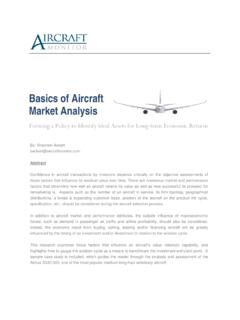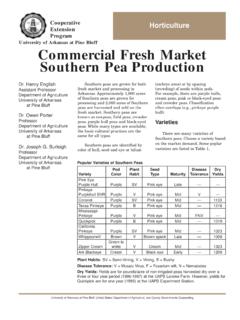Transcription of Maize International Market Profile
1 Background paper for the Competitive Commercial Agriculture in Sub Saharan Africa (CCAA) Study Maize International Market Profile Abdolreza Abbassian Trade and Markets Division Food and Agriculture Organization of the United Nations Disclaimer: This background report is being made available to communicate the results of Bank-funded work to the development community with the least possible delay. The manuscript therefore has not been prepared in accordance with the procedures appropriate to formally edited texts. Some sources cited in this report may be informal documents that are not readily available. The findings and interpretations expressed in this report are those of the author(s) and do not necessarily reflect the views of the Board of Executive Directors of the World Bank or the governments they represent, or those of the Food and Agriculture Organization of the United Nations (FAO).
2 The World Bank and FAO do not guarantee the accuracy of the data included in this work. The designations employed and the presentation of the material in this work, including the boundaries, colors, denominations, and other information shown on any map do not imply any judgment on the part of the World Bank or FAO concerning the legal status of any territory or the endorsement or acceptance of such boundaries. Maize : International Market Profile1. 1 Introduction Maize is the third largest planted crop after wheat and rice. It is mostly used and traded as a leading feed crop but is also an important food staple. In addition to food and feed, Maize has wide range of industrial applications as well; from food processing to manufacturing of ethanol. This report discusses the significance of Maize in the global context.
3 It begins by providing an overview of the different origins/types of Maize as well as describing its planting characteristics. Next it discusses the International Maize economy and describes some of the main factors which have contributed to developments in production, consumption, and trade of Maize over the past two decades. In the final analysis, the FAO's assessments of the current state of the world supply and demand balance for Maize as well as its medium term outlook are presented. Statistical tables providing 10 years of data on production, total utilization, feed use, trade flows, stocks, freight rates, food aid shipments, co-products and prices are provided in Annex I. A descriptive list of selected on-line resources that provide Market information on Maize is included in Annex II.
4 Origins and Varieties Maize is one of the oldest human-domesticated plants. Its origins are believed to date back to at least 7000 years ago when it was grown in the form of a wild grass called teosinte in Central Mexico. Recognizing its early potential as a major food crop, over time the Mesoamerican natives managed to improve the crop, by systematically selecting certain varieties for their desired traits. This process led to the gradual transformation of teosinte to its present day form known as Maize , a name which is a likely derivative of "mahis", meaning "source of life" for Tanio people, the natives known to have mastered its cultivation. Maize is also known as corn, which is the name that has come into common usage primarily because it is used in the United States, the world's largest producer, consumer and exporter of Maize .
5 This reference to corn, rather than Maize , in the United States can be traced to the arrival of the early European settlers in the New World when Maize was referred to as Indian corn . Indian corn is a type of Maize known for its colourful kernel (or seed) which is scientifically known as Zea mays. The term corn most likely originates from the Germanic korn' which referred to any edible grass. The importance of corn in North American heritage could not be more evident than in the history of the annual Thanksgiving celebration, the origin of which dates back to the first celebrations by the Pilgrims and the Native Americans who gave thanks for the corn harvest . Maize is an annual plant with high productivity which also enjoys exceptional geographic adaptability, an important property which has helped its cultivation to spread throughout the world.
6 Its gradual expansion in the Americas by the Natives was rapidly propagated in the 16th century following the return of Columus to Europe. Colonial conquests and trade played a central role in the spread of Maize cultivation well beyond the European continent, to Africa and Far East Asia. There exist several hybrids of Maize , each with their own specific properties and kernel characteristics; the most common ones include: dent (or field Maize , used for livestock feeding and can be yellow or white), flint (or Indian Maize , grown mostly 1. Generous collaboration and inputs were provided by John Heine and Claudio Cerquiglini. 2. in Central and South America), and sweet (or green Maize ). Depending on their colour and taste, Maize grown around the world is generally categorized into two broad groups: yellow and white.
7 Yellow Maize constitutes the bulk of total world Maize production and International trade. It is grown in most northern hemisphere countries where it is traditionally used for animal feed. White Maize , which requires more favourable climatic conditions for growing, is produced in only a handful of countries, the United States, Mexico and in southern Africa. White Maize is generally considered a food crop. Market prices are usually higher for white Maize compared to the yellow type but the premium can vary depending on local supply and demand conditions. Grades and Production Cycles As with other cereals, for commercial and marketing purposes, Maize is also assigned different types of grades and classes depending on a set of physical descriptions or qualities such as the minimum test-weight, feeding values, and maximum limits of damaged kernels and foreign material.
8 In the United States, for example, Maize classes are determined on the basis of colour (divided into yellow, white and mixed) and are graded from 1 to 5 (Table 1 ). The No. 2 grade of Maize is widely considered as the traditional representative price for Maize produced in the United States; it is also accepted as the world's most representative price for Maize and other coarse grains. Table 1 - Grade Requirements for Maize in the United States (percent). Minimum Maximum Limits of Damaged Kernels Broken Test Weight Corn and Heat- Per Bushel Foreign Damaged Grade (Pounds) Moisture Material Total Kernels No. 1 56 2 3 No. 2 54 3 5 No. 3 52 4 7 No. 4 49 5 10 No. 5 46 7 15 SOURCE: Agricultural Marketing Service, USDA. 1 bushel = metric tonne and 1 tonne= pounds Planting size and growing conditions are critical elements in determining price developments.
9 For this reason, much effort is often spent on monitoring crop conditions during the production cycle (Table 2). One important advantage of agricultural crops is that they are renewable and take fairly short time to produce. Some crops such as Maize are also produced in both the northern and southern hemispheres and this can be regarded as an additional stabilization bonus as the world harvests staggered throughout the year. Of course, any sudden turn in the weather and/or spill price effects arising from supply and demand developments in other markets can still influence Maize spot and near-term prices during any given season but those conditions are usually sporadic as Market behaviour is mostly driven by its own supply and demand fundamentals. 3. Table 2 Maize Crop Cycles and Importance of Weather on Prices Northern Hemisphere Southern Hemisphere Month Crop Stage Weather Crop Stage Weather January Silking C.
10 February Filling C. March Maturing C. April Planting M Harvesting M. May Planting M Harvesting M. June Dormant M. July Silking C. August Maturing C. September Harvesting C Planting M. October Harvesting M Planting M. November Harvesting M Planting M. December Dormant M. SOURCES: FAO/USDA/ Dean Witter M= Time of year weather can be a Major price determining factor. C= Time of year weather can be a Most Critical price determining factor. One factor which causes serious problems for Maize production from time to time is the occurrence of El Ni o, a weather phenomenon which is associated with significant abnormal warming of sea-surface temperatures in the Pacific Ocean. The Maize crops that are most affected by the El Ni o (mostly in the form of prolonged dry conditions) are largely concentrated in the southern hemisphere, in particular in southern Africa.














